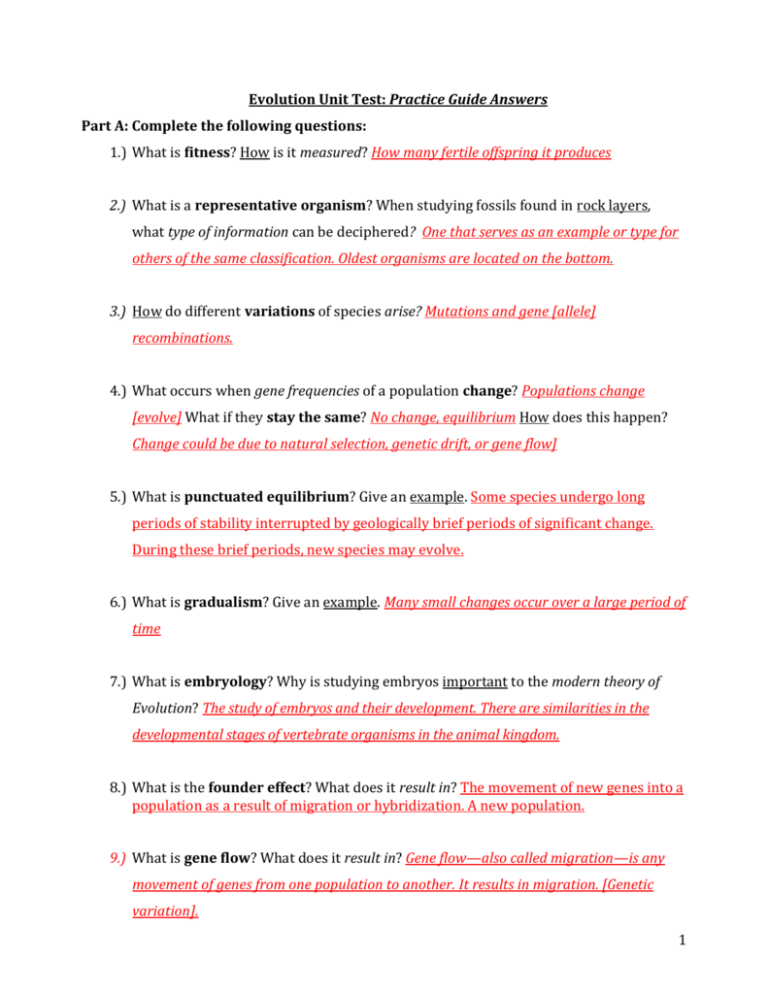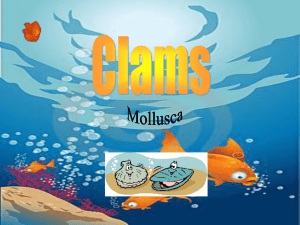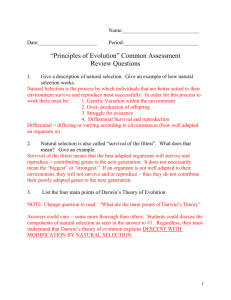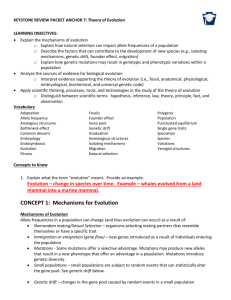Evolution-Practice-Guide
advertisement

Evolution Unit Test: Practice Guide Answers Part A: Complete the following questions: 1.) What is fitness? How is it measured? How many fertile offspring it produces 2.) What is a representative organism? When studying fossils found in rock layers, what type of information can be deciphered? One that serves as an example or type for others of the same classification. Oldest organisms are located on the bottom. 3.) How do different variations of species arise? Mutations and gene [allele] recombinations. 4.) What occurs when gene frequencies of a population change? Populations change [evolve] What if they stay the same? No change, equilibrium How does this happen? Change could be due to natural selection, genetic drift, or gene flow] 5.) What is punctuated equilibrium? Give an example. Some species undergo long periods of stability interrupted by geologically brief periods of significant change. During these brief periods, new species may evolve. 6.) What is gradualism? Give an example. Many small changes occur over a large period of time 7.) What is embryology? Why is studying embryos important to the modern theory of Evolution? The study of embryos and their development. There are similarities in the developmental stages of vertebrate organisms in the animal kingdom. 8.) What is the founder effect? What does it result in? The movement of new genes into a population as a result of migration or hybridization. A new population. 9.) What is gene flow? What does it result in? Gene flow—also called migration—is any movement of genes from one population to another. It results in migration. [Genetic variation]. 1 10.) What is a population bottleneck? What does it result in? It is an event that drastically reduces the size of a population. The bottleneck may be caused by various events, such as an environmental disaster, the hunting of a species to the point of extinction, or habitat destruction that results in the deaths of organisms. Genetic drift acts more quickly to reduce genetic variation in small populations, undergoing a bottleneck can reduce a population’s genetic variation. 11.) What factors affect genetic diversity? Adaptations to environment 12.) What factors contribute to a change in the allele frequency of a population? Mutations and sexual reproduction 13.) What is the difference between geographic isolation and reproductive isolation? What can each result in? Geographic isolation refers to the separation of two populations by physical boundaries, such as rivers, mountains, etc. Reproductive isolation occurs when two populations no longer produce viable offspring. This can be due to geographical isolation or other factors such as behavioral differences. 14.) How were so many different types of finches able to survive on the Galapagos Islands? Birds adapting to different island environments 15.) What is natural selection? What does it act on? What does it result in? Natural selection acts on individuals, which in turn may result in the evolution of populations over time. 16.) Describe the illustration below in a complete sentence. What process is occurring? The evolution of the horse occurred over a period of 50 million years, transforming the small, dog-sized, forest-dwelling Eohippus into the modern horse Equus. Evolution! 2 17.) What is adaptive radiation? Give an example. Biologists have found more than 500 species of fruit flies on various Hawaiian Islands, all of them coming from a single ancestor species. 18.) How are mutations related to Evolution? How do they occur? Mutations can be considered as one of the raw materials of evolution because they contribute to new variations in organisms. 19.) Why are fossils an integral piece of evidence for the modern theory of Evolution? Organisms on Earth have evolved and changed significantly over time. 20.) What is a homologous structure? Give an example. Similar [Same] structures, but different functions, and likely evolved from the same distant ancestor. The leg of a cat and the wing of a bat. 21.) What is an analogous structure? Give an example. Different structures. The wing of an insect and the wing of a bat. 22.) What is a vestigial structure? Give an example. Structures that no longer have any function. The human appendix. 23.)What are the five pieces of evidence for Evolution? 1. Fossils 2. Homologous Structures 3. Vestigial Structures 4. Embryology 5. Biochemistry- more genes/proteins in common means organisms are more closely related. 24.)Who is Charles Darwin? A naturalist, known for his contributions to evolutionary theory. Why is he important to the Theory of Evolution? Natural Selection acts Genotypes Part B: Use the table to fill in the cladogram below: 3 25.) Salamander Horse Pig Chimpanzee 2 h i m p a n z e e 0 h i m p a n z e e Time 27 Chi mp anz ee 14 Chi mp anz ee Humans C h i C m Part C: Answer the following questions concerning the study on clam h shell color. p i 26.)A population containing spotted and unspotted clams has surfaced on the shoesa of New m The seagulls Jersey. The seagulls break the clams open by dropping them onto rock jetty. eat n p the bodies of the clams and leaves the shells. Researchers have counted the number z of live a clams and broken clam shells. The data is below. e n e Spotted Shells z Unspotted Shells Living Clams 150 165 e e Broken Shells (dead clams) 387 212 79 a.)Which clam is more likely to get caught? Spotted shell Why? 387 are dead b.)How will allele frequencies change over time? More unspotted shells c.)Which allele is favored? More unspotted shells Why? They are living d.)Which allele does natural selection work against? Spotted shell Why? They are dead Good Luck Studying!!!!! 4











